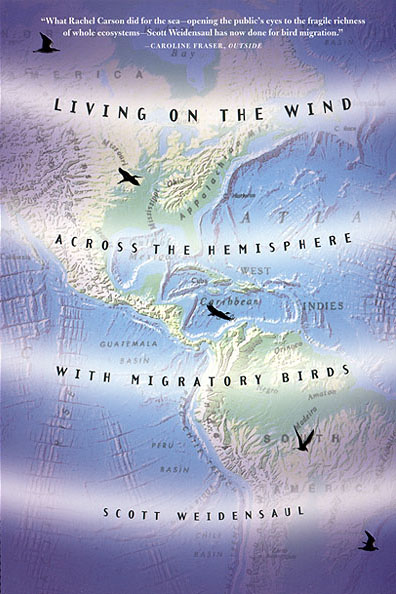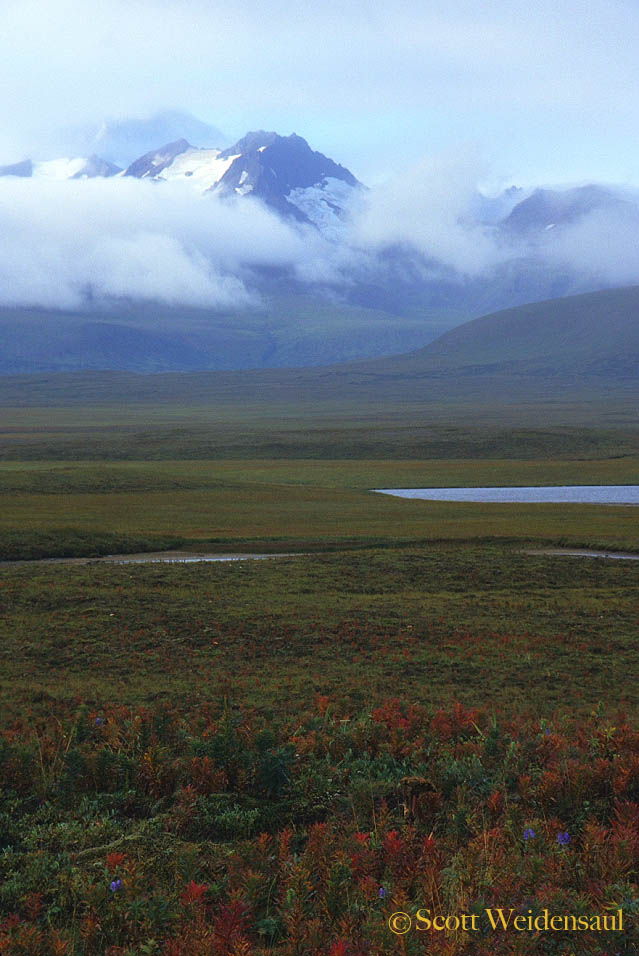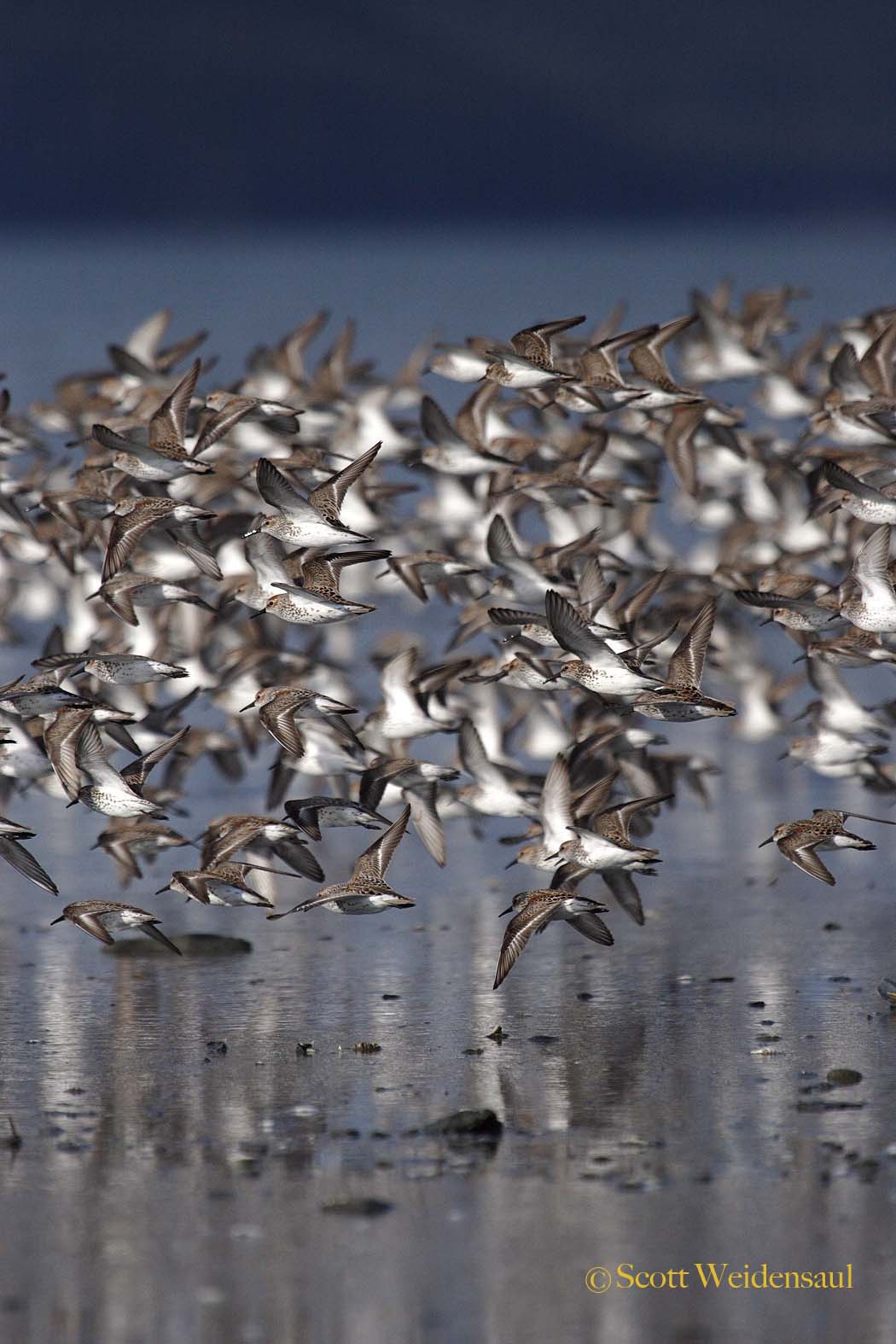EXCERPT from Living on the Wind
 1: Beringia
1: Beringia
Mist clouded my glasses, and a breeze lashed the long, coarse grass on the steep bluff where I sat. The knife-edge headland jutted into the gray Bering Sea, its slopes spangled with the late-summer blue of monkshood flowers. Fifty or sixty feet below me, waves washed on a cobbled beach of round black rocks, each surge making the smallest pebbles snicker lightly against one another.
The tide was half out, and looking through gaps in the fog across the half-mile width of Izembek Lagoon, I could see a delicate ruffle to the surface of the water - the tips of great eelgrass beds were just dimpling the top, and smooth channels of open water branched through them like roads. In one of these channels, a harbor seal's blocky head emerged from the waves for a brief moment, blinked its eyes, then disappeared. Nearby, two sea otters lay sprawled on their backs, wrapped in the sinuous eelgrass to keep from floating away; one was working at dinner, using its paws and teeth to wrench apart a crab.
Through the fog came a sound, a creaky, three-noted honk - Claa-ha-aa! Claa-ha-aa! - like someone blowing on a clarinet reed. A small flock of emperor geese broke into clear air, eight of them rowing against the wind -- dark, purplish-black bodies and white heads stained with rusty orange from feeding in iron-rich tundra ponds. As the mist lifted, I saw birds in almost every direction: skeins of small, dark geese called brant, in hurried flight; squadrons of eiders and scoters and other sea ducks riding the swells, pudgy as footballs; swirls of kittiwakes, long-winged gulls with balletic grace; and smokelike tendrils against the horizon that were thousands of shorebirds, rising and falling on distant mudflats exposed by the dropping tide.
At the very edge of the continent, I was looking off across the Bering Sea toward hidden Siberia and the Old World. Izembek National Wildlife Refuge lies at the tip of the Alaska Peninsula, where this crescent of rugged land dissolves into the thousand-mile arc of the Aleutian Islands. It is a land of fire and ice, of alpine snowfields and active volcanoes, like one of the rugged cones that flank nearby Cold Bay.
 A land of active volcanoes, shallow lagoons and soggy tundra, Izembek National Wildlife Refuge is a global crossroad for migratory birds, which spread out across three-quarters of the Earth's surface when they leave this part of western Alaska. (©Scott Weidensaul)I came to Izembek in early September, after weeks of wandering across western Alaska, because this tendril of land is a global crossroads. Fifteen or twenty thousand years ago, during the height of the last ice age, continental glaciers captured much of the world's water and sea levels were hundreds of feet lower. What is now the shallow Bering Sea was then a marshy land bridge, a port of entry between Asia and America. Across this bridge, named Beringia by geologists, humans wandered from Siberia, hunting mammoths, giant bison, and other ice age game, colonizing a new world.
A land of active volcanoes, shallow lagoons and soggy tundra, Izembek National Wildlife Refuge is a global crossroad for migratory birds, which spread out across three-quarters of the Earth's surface when they leave this part of western Alaska. (©Scott Weidensaul)I came to Izembek in early September, after weeks of wandering across western Alaska, because this tendril of land is a global crossroads. Fifteen or twenty thousand years ago, during the height of the last ice age, continental glaciers captured much of the world's water and sea levels were hundreds of feet lower. What is now the shallow Bering Sea was then a marshy land bridge, a port of entry between Asia and America. Across this bridge, named Beringia by geologists, humans wandered from Siberia, hunting mammoths, giant bison, and other ice age game, colonizing a new world.
Beringia was inundated roughly eleven thousand years ago, as the glaciers melted and the seas rose. But Asia and America still nearly touch here, a brushing kiss across the 50-mile-wide Bering Strait, and Beringia is still a way station of international significance. Some of the travelers come by sea: gray whales from Baja, salmon returning to their natal streams from the black waters off Japan and Korea, northern fur seals hauling out on the rocky islands of the Pribilofs. But far more journey by air. Many birds whose travels span the globe breed in western Alaska, and now, as summer faded to autumn, they were taking to the wind once more.
They were not leaving because the weather would soon turn cold - although it would, the raw, bone-deep cold of coastal Alaska, with its sea ice and wet snow and howling winds. Migration is, fundamentally, about food, not temperature; those birds that can continue to find enough to eat during the winter rarely migrate - why bother? - while those whose food supplies are seasonal must flee. Almost all of the more than five hundred North American species that migrate depend on weather-sensitive food supplies - the ducks and wading birds whose marshes are sealed with ice, for instance, or the insectivorous songbirds that can't find bugs in a December snowstorm. Seed-eaters are less likely to migrate than insect-eaters and tend not to go as far when they do; they can find plenty of weed seeds in North Dakota in January, but for flying insects a bird must travel at least to the Gulf States, or all the way to the tropics.
Behind me, a small cove lay in the protective lee of the bluff. Windrows of dead eelgrass formed thick, snaky ropes at the high-water mark, black against the oily gray of the mudflats. Flocks of shorebirds were feeding there with restless energy - scurrying, probing, poking into the rich tidal muck for small invertebrates. Most of the birds were dunlin, small sandpipers with drooping bills, many still in breeding plumage, with reddish backs and black bellies, as though they'd squatted in soot. Every few minutes, responding to some silent signal of alarm, they would leap into the air, wings flashing white, then twist and circle to earth again to resume foraging.
Migration is not the simple, north-to-south-and-back-again affair that most of us assume, and the shorebirds feeding on that mudflat were a perfect example. Dunlin breed in much of Alaska and the Canadian Arctic, but they form three distinct populations, each with radically different migration routes. Those that I was watching were probably of the subspecies pacifica, which nests in this part of southwestern Alaska and travels relatively short distances along the coast, stopping anywhere from the southeastern Alaskan panhandle to Baja California. Dunlin that nest in the central Canadian Arctic, on the other hand, migrate overland to the southern Atlantic and Gulf Coasts, of the United States. And those that breed in the Northwest Territories and northern Alaska cross the Bering Strait to Siberia, where they join Russian dunlin and migrate on to eastern China, Japan, and Korea.
Among the masses of dunlin were a number of other species of shorebirds, each laying on fat before departing for far-flung destinations. Rock sandpipers, matching the gray volcanic stone, would barely budge; although some would travel to California, many would pass the wet, gloomy winter right here. Least sandpipers no bigger than sparrows, like little, buffy windup toys, would skirt the coast to South America. Among them were two Pacific golden-plovers, the color of hand-worn brass, which might take one of two routes from Alaska. Some cross the Bering Strait and follow the Asian coast, finally veering southeast to Australia or the Pacific islands. Others fly southwest across the open ocean to Hawaii, and then on to the islands of the South Pacific; some apparently make the flight to the Marshall and Line Islands - a thousand miles south of Hawaii, and a trip of nearly 4,000 miles - in a single, nonstop flight. Others on the beach and flats that day would make similar migrations - the wandering tattler, a whimsically named sandpiper, which winters across much of the South Pacific, and the squat, piebald ruddy turnstone, which travels to Southeast Asia, Australia, and the islands of Oceania, as well as to the California coast.
 Western sandpipers (©Scott Weidensaul) This single acre of mud held examples of a dozen different migration strategies. Not far from the Pacific golden-plovers stood five American golden-plovers, close cousins distinguished (with difficulty) by their duller plumage and somewhat longer wings. They also breed in western Alaska and make equally epic trips, but in the opposite direction. First they fly east across Arctic Canada, feasting on its wealth of berries and insects before gathering in the Atlantic Maritime provinces; then they swing south, cutting across the western Atlantic nearly 2,000 miles to South America, eventually ending their trip in the grasslands of Argentina. Joining them on the pampas would be greater yellowlegs, which I had seen earlier in the day along freshwater streams flowing into Izembek Lagoon - graceful sandpipers with steely-gray plumage and colorful, ripe-lemon legs. From the muskeg forests of Alaska and Canada, the yellowlegs spill south each autumn across the hemisphere, but they take an overland route, some stopping as far north as the Pacific Northwest and mid-Atlantic coasts, but others pushing on clear to Patagonia.
Western sandpipers (©Scott Weidensaul) This single acre of mud held examples of a dozen different migration strategies. Not far from the Pacific golden-plovers stood five American golden-plovers, close cousins distinguished (with difficulty) by their duller plumage and somewhat longer wings. They also breed in western Alaska and make equally epic trips, but in the opposite direction. First they fly east across Arctic Canada, feasting on its wealth of berries and insects before gathering in the Atlantic Maritime provinces; then they swing south, cutting across the western Atlantic nearly 2,000 miles to South America, eventually ending their trip in the grasslands of Argentina. Joining them on the pampas would be greater yellowlegs, which I had seen earlier in the day along freshwater streams flowing into Izembek Lagoon - graceful sandpipers with steely-gray plumage and colorful, ripe-lemon legs. From the muskeg forests of Alaska and Canada, the yellowlegs spill south each autumn across the hemisphere, but they take an overland route, some stopping as far north as the Pacific Northwest and mid-Atlantic coasts, but others pushing on clear to Patagonia.
Simply cataloging the avian wanderers that pass through western Alaska would be a lengthy chore. Virtually every black brant on earth stops at Izembek in autumn, feeding on the world's most expansive eelgrass beds, before moving out in November for destinations as far away as Mexico. Most of the world's emperor geese and Steller's eiders, the latter a threatened species, congregate at Izembek in the fall; the geese move on to the Aleutians for the winter, but the ducks stay put in the sheltered lagoons.
In Beringia, a naturalist may find Hudsonian godwits bound for Tierra del Fuego and bar-tailed godwits headed for New Zealand; the small greenish songbird known as the Arctic warbler, which migrates to the Philippines, and Wilson's warbler, yellow with a black cap, which flies to Central America. There are fox sparrows and golden-crowned sparrows that winter in Pacific coastal woodlands, and gray-cheeked thrushes that travel to the Amazon. All morning, I had been watching wheatears, black-and-white songbirds that look like slim thrushes. They'll join their Siberian brethren and fly to China and India, then continue on to eastern Africa together, while wheatears from the eastern Arctic swing across Greenland and Iceland to reach western Africa by a European route, embracing the world in a wishbone of movement.
Out on the ocean around Izembek were more migratory wonders. The day before, an Aleutian gale had savaged the region, ripping even protected harbors to foam and fury. But from a sheltered nook overlooking Cold Bay, I had watched dark shapes skimming the waves, gliding on stiff, narrow wings that barely cleared the tops of violent whitecaps, to all appearances blithely unconcerned by the storm. These were shearwaters, fittingly named seabirds that spend virtually their entire lives on the open sea and that are among the world's most accomplished migrants.
This particular species, the short-tailed shearwater, nests on small islands off the south coast of Australia and Tasmania. In April and May, at the conclusion of the breeding season, millions of shearwaters pour rapidly north along the western Pacific rim, taking advantage of the prevailing winds--across Oceania, past Japan, and into the Bering Sea a month later, where they enjoy perpetual subarctic daylight and a rich food supply. They remain off Beringia until September, when they head down the American coast and across the central Pacific, again aided by local wind currents. The shearwaters return to Australia by late October or November, when observers along the coast of New South Wales have seen as many as 60,000 an hour going past, a torrent of birds fueled by the bounty of the Bering Sea. A short-tailed shearwater may cover more than 18,000 miles in a single year, carving a vast circuit on the Pacific, aided at each step of the way by the prevailing breeze - and yet they arrive back in Australia within the same eleven-day period each year.
Migrations like this leave us staggered; we are such stodgy, rooted creatures. To think of crossing thousands of miles under our own power is as incomprehensible as jumping to the moon. Yet even the tiniest of birds perform such miracles.
